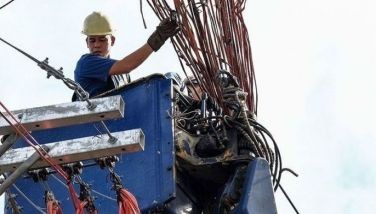The power crisis in Mindanao

The electricity problem in Mindanao has been a crisis waiting to happen. The signs had been known by all concerned for years, especially by the national government. Inaction on the required policy front meant that the day of reckoning would simply arrive and blow up the picture. That has now become a reality.
Government inaction to do the right thing was due to a paralysis of decision-making. Lack of strong national leadership on the issue permitted conflicting interests to create a stalemate in decision making. The stake holders in the power supply problem acted in opposite and conflicting directions.
“Crisis of electricity in Luzon in the 1990s.” This is not the first time that a region-wide power crisis has happened in the country. The power crisis of Luzon during the early 1990s comes to mind. It was by far more serious. It cost the nation almost a decade of sporadic power supply interruptions. That crisis has hampered our international competitiveness to this day.
The 1990s crisis resulted from a sin of commission. When it took power, the Cory Aquino government squandered the investments in power capacity of the previous Marcos government. It shelved the nuclear power plant which was ready to start operation.
“Policy inaction in the Mindanao situation.” The present crisis of power in Mindanao is due to government inaction. The government did not pursue the series of long term actions required to solve the power development problems of Mindanao.
First, the Mindanao electricity distribution grid was not connected to the Luzon-Visayas grid. This would have accomplished an integration of the grid system of the nation.
Second, the base load of power generation for the region was not increased sufficiently. The decision to undertake approvals was snail paced.
Third, the privatization of the government generating power plants, following the logic of EPIRA (Electricity Power Industry Reform Act), was not undertaken.
“The electricity grid connection impasse.” Mindanao stakeholders in the electricity system did not want to be connected to the Luzon-Visayas grid. They did not want to be associated with the power cost issues of the larger nation. By doing so, it could not depend on the geothermal electricity generation plants in Leyte.
The electric distribution grid as built is linked mainly with hydroelectric power generation. This is the cheapest power source and the communities with access to that source wanted their connection mainly to cheap power. Thus, a broader network of electrification grid was not achieved.
“Base load expansion impasse.” The base load capacity for Mindanao is far from stable. Hydroelectric power is highly seasonal and becomes lowest during the dry and hot months of the year when power demand is highest.
To stabilize the base load, capacity expansion in the direction of other sources of energy is required but this has not been fast-tracked. Coal power projects had taken too long for decision at the Department of Energy. Much attention was given toward further expansion of the hydropower projects and little to alternative sources such as geothermal power.
‘Hydroelectric power base.’ The government has always held the potentials of hydro-power from the Agus River. The flow of water from Agus River II had to be properly harnessed for improved power production for Agus III.
But Agus II water overflows cause the flooding of the Baloie agricultural plains. The solution is to build an intricate flood control project that includes high dikes and irrigation channels. This problem of long-standing knowledge is only in the feasibility studies stage.
“Privatization.” Privatization is the solution offered by EPIRA to get the government out of the industry and to improve the efficiency and costs of electricity service delivery.
The national government undertook the privatization of power assets of the country with the exception of the generating power assets in Mindanao. However, it privatized the entire grid system in Mindanao and is now part of the National Grid Corporation of the Philippines.
The local communities, the electric power distributors which are mainly electricity cooperatives, and local politicians have resisted the privatization of the hydroelectric power assets. As a result, little else by way of privatizing the hydroelectric power plants has resulted in Mindanao.
There is growing evidence that the privatization of the hydroelectric power plants in the whole country is working well. With the government being relieved from the task of operating the generating plants, gains in efficiency and in service delivery improvements have become noticeable among the privatized plants.
“Breaking the policy impasse.” Given the relative deficiency of power in Mindanao, why has the base load capacity remained relatively slow to expand? There ought to be more interested power investors aside from the Aboitizes and the Alcantaras in such a big region. Are power companies held back by the process of choice or by the system?
The slowness of the government can only be explained by an effort not to be in the thick of the conflict of interests in setting the course right. To be sure, the Aquino administration only inherited the problem from its predecessor.
The Macapagal administration was paralyzed in undertaking the right action on the long term power problem of Mindanao. Because it was politically weak, it tried to coddle local sentiments and could not look to the long term economic solutions.
In contrast and for the first two years in office, the Aquino administration has been too concerned with big anti-corruption issues at the national level. The leadership could not be bothered by the details of micro-sectoral and regional problems. Out of neglect, therefore, these problems exploded into view when the room for waiting no longer exists.
Thus, the short term response of the government is to deploy floating power barges to raise supply. The generation costs of electricity of these barges which depend on diesel are more than three times those of hydroelectric power. The other measures have to do with undertaking regulatory steps that inevitably lead to higher electricity prices.
Getting the long term solution to the power problem to take hold will test the Aquino administration’s resolve to deal with this issue. If Mindanao is to grow according to the economic plan’s projections, the power needs will have to grow.
The Energy Department says that on stream is a 200 mw plant fired on coal and a 50 mw geothermal generating plant that will be added to the base load in two years’ time. If this time frame is met, there will surely be a greater need for more power generation. The growth of agriculture, commerce and industry in Mindanao will demand more electric power if it is to fulfill its economic promise.
My email is: [email protected]. Visit this site for more information, feedback and commentary: http://econ.upd.edu.ph/gpsicat/
- Latest
- Trending































